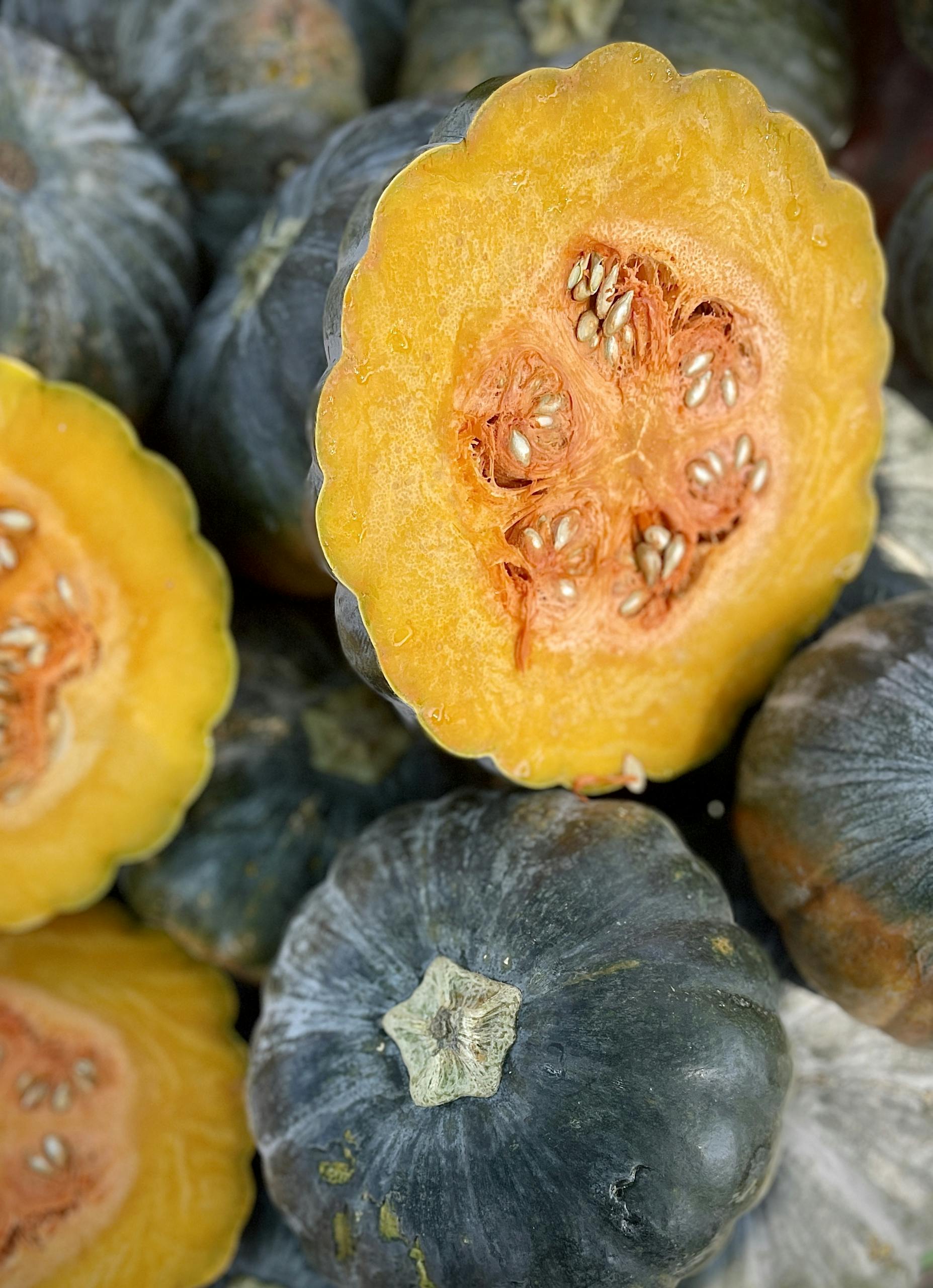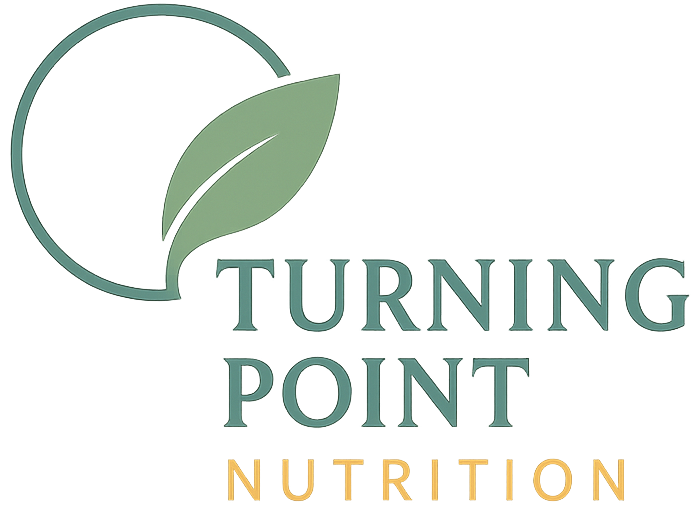
It’s squash season: butternut, acorn, delicata, kabocha, spaghetti. These cozy, budget-friendly gourds are more than just fall décor (although they look GREAT in a bowl on your kitchen table…) they’re also a simple and under-utilized lever for women dealing with midday fatigue, wired-tired nights, creeping scale weight, and that “food feels out of control” spiral. Why? Used strategically, winter squash gives you satisfying volume and fiber with a steadier blood-sugar curve so you feel full longer, snack less at night, and wake up feeling more like yourself.
Why Winter Squash for Health?
- Food volume without the carb overload: Big, comforting portions that don’t blow up your day’s carbs or calories; you feel energized rather than weighed down.
- Plays nicely with protein & fiber: Squash is your smart carb: pair it with 25–30g protein + a little fat for consistent energy and fewer cravings.
- Comfort food that supports goals: Creamy soups, roasted halves, and chopped bits serve as the perfect cozy side
Antioxidants & fiber
- Carotenoids for cell protection: Winter squash flesh naturally concentrates carotenoids like β-carotene, lutein, and zeaxanthin—antioxidants that help neutralize oxidative stress. In popular cultivars (e.g., Waltham butternut; kabocha “Sunshine”), storage after harvest can even increase total carotenoids, with β-carotene and lutein among the major compounds. ASHS
- What those carotenoids do: β-carotene is a vitamin A precursor (important for immune function and epithelial/eye health), while lutein and zeaxanthin are macular pigments with antioxidant roles. Food sources are the preferred route for these compounds. Office of Dietary Supplements+1
- Fiber types that help your day:
- Soluble/viscous fiber (e.g., pectins in fruits/veg) forms a gentle gel that slows glucose absorption which is useful for mitigating that 3 p.m. crash. The Nutrition Source
- Insoluble fiber (cellulose/hemicellulose in veg cell walls) adds bulk and regularity that is helpful when your bowel functioning is off. The Nutrition Source
(TLDR: squash provides antioxidants that reduce oxidative stress in cells, and the fiber mix helps your meals sustain you for longer, so cravings don’t creep in to sabotage your health goals.)
Smart Swaps with Squash
- Spaghetti squash → trade for part or all of pasta/noodles when you want a bigger, satiating bowl without any food guilt
- Butternut or kabocha → swap for some rice or potatoes when you want creamy interiors and crispy bites that pack more fiber and antioxidants.
- Delicata or acorn → use as the “carb” on your plate in place of bread/rolls; great for stuffed, one-pan dinners.
Quick rule: If you want volume, reach for spaghetti squash. If you want cozy creaminess, reach for butternut/kabocha. If you want fast weeknight dinners, go delicata or acorn.
My Favorite Squash and How to Use Them
- Butternut (dense, velvety): soups, mashes, sheet-pan cubes.
- Acorn (mild, halves): roast and stuff with turkey + quinoa or beans.
- Delicata (edible skin): slice into rings; roasts in ~20 minutes (and so sweet!)
- Kabocha (extra dense, naturally sweet, edible skin): stews, curries, oven fries that crunch and retain starchiness
- Spaghetti squash (strand-y): pasta-style bowls under ragu, pesto, or marinara.
Seasonality note: peak availability fall through winter; buy mid-October-November while prices and flavor are best.
Your Guide to Buying, Prepping and Eating
1) This week, pick two:
- 1 dense squash (butternut or kabocha) for soups/mashes
- 1 quick squash (delicata or spaghetti) for weeknights
2) How much to buy (approx servings):
- Butternut (2–3 lb): 4–6 cups cooked (4–6 sides or 2–3 mains)
- Acorn (1–2 lb): 2–3 cups (2 mains if stuffed)
- Delicata (¾–1 lb): 2–3 cups rings (2 sides)
- Kabocha (2–3 lb): 5–7 cups (4–6 sides or 3 mains)
- Spaghetti (3–4 lb): 4–6 cups strands (2–3 pasta-sized mains)
3) Storage:
- Whole: in a cool, dry place. Butternut/kabocha for ~1 month; delicata/acorn for ~2-3 weeks; spaghetti squash for ~1 month
- Cut: wrap and refrigerate 3-5 days
- Cooked: fridge 3-4 days; freeze up to 3 months (soups/purees freeze best)
4) Shortcuts for those that don’t have time to roast: pre-cut butternut, frozen cubes, canned 100% pumpkin puree, microwave-ready spaghetti squash halves, freeze-fried spaghetti squash.
5) Portions on your plate:
- Treat winter squash as your healthy carb.
- Side: ½-1 cup cooked
- Bowl base: 1-2 cups (use spaghetti squash for more volume)
- Always add 25–30g protein plus a little healthy fat to round out your plate and support energy and metabolism.
Simple Dinner Inspiration
Dinner 1 — Spaghetti Squash Ragu
Roast strands. Top with turkey or lentil ragu, spinach, and a spoon of ricotta or pesto.
Symptom support: Cozy evenings, fewer late-night snack cravings.
Dinner 2 — Stuffed Acorn Boats
Roast halves. Fill with ground turkey + quinoa or black beans, herbs, olive oil.
Symptom support: holds you through the evening; less grazing.
Dinner 3 — Butternut and White Bean Soup
Blend roasted butternut with broth, garlic, sage, cottage cheese and white beans; finish with lemon.
Symptom support: cozy, higher-fiber meal that doesn’t leave you hunting for dessert.
Lunch — Delicata Power Salad
Roasted delicata rings + arugula + salmon or roasted tofu + pumpkin seeds + vinaigrette.
Symptom support: no 3 p.m. crash.
Breakfast — Butternut Protein Oats
Stir ½ cup mashed butternut + a scoop of protein powder into oats; top with walnuts + cinnamon.
Symptom support: calmer morning energy; fewer mid-morning snacks.
3-Cay Reset and Work with Me!
For the next three dinners, swap in one of the formulas above and pair with 25–30g protein. Notice your afternoons, your bedtime, and your wake-ups getting better. When you feel more energized and lighter, keep going!
Want it done for you? Grab my free Turning Point 3-Day Reset (menus, grocery list, snack matrix). If you’re ready to personalize for hormones, labs, and your schedule, book a Clarity Call and we’ll map your next steps.You don’t need a new diet. You need a better plan for you plate. Seasonal winter squash is an easy, delicious place to start.

